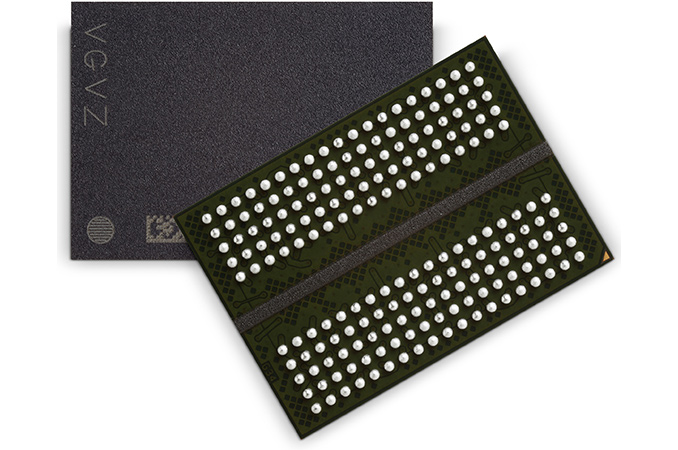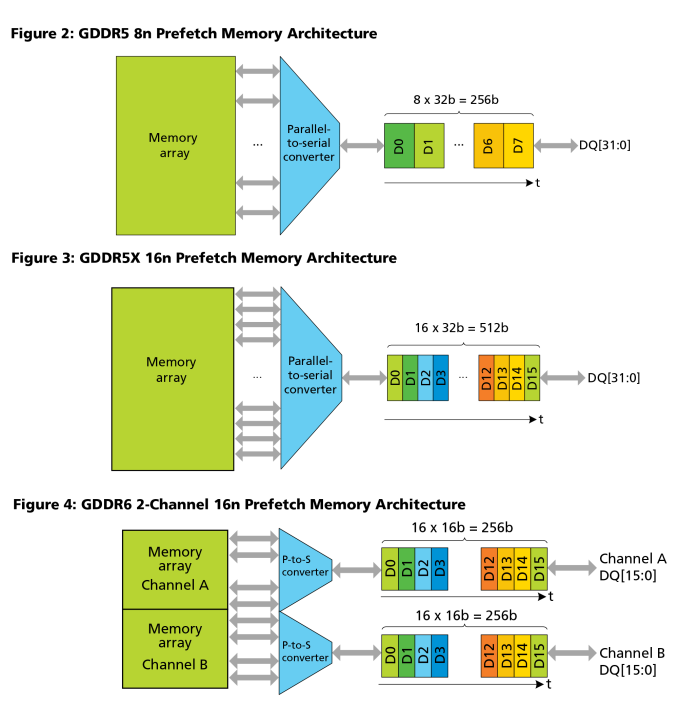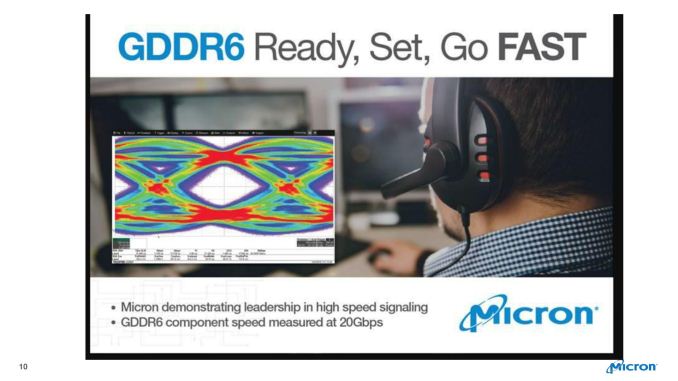Micron Begins Mass Production of GDDR6
by Ryan Smith on June 25, 2018 9:00 AM EST
This morning Micron is announcing that they’ve kicked off production of their next-generation GDDR6 memory. This next step in production comes on the heels of their internal qualification, which was completed in late 2017, and arrives just in time to reach their H1’2018 mass production goal. With this announcement Micron has become the third memory and final vendor among the industry’s Big 3 to produce GDDR6, as the pieces continue to fall into place for GDDR6 to become the true successor to the now decade-old GDDR5.
For Micron’s product lineup they’re launching with 8Gbit chips at a few different speeds. For the graphics market – where the bulk of consumer interest in GDDR6 certainly lies – Micron is releasing chips rated for 12Gbps and 14Gbps, both of which operate at 1.35v. This is down from 1.5-1.6v for GDDR5, and is where a good chunk of GDDR6’s power consumption savings come from. Meanwhile a bit farther down the line Micron intends on releasing 16Gbps chips as well (and indeed already has part numbers for them).
| Micron 8 Gb GDDR6 Memory Chips | ||||||||
| Market | Part Number | Packaging | Data Rate | Bandwidth per Chip |
Voltage | Organization | ||
| Graphics | MT61K256M32JE-14:A | GDDR6 180-ball |
14 Gbps | 56 GB/s | 1.35 V | 256Mx32 | ||
| MT61K256M32JE-12:A | 12 Gbps | 48 GB/s | 1.35 V | |||||
| Networking | MT61M256M32JE-12N(IT):A | 12 Gbps | 48 GB/s | 1.25 V | ||||
| MT61M256M32JE-10N(IT):A | 10 Gbps | 40 GB/s | 1.25 V | |||||
| Automotive | MT61M256M32JE-12AAT:A | 12 Gbps | 48 GB/s | 1.25 V | ||||
| MT61M256M32JE-10AAT:A | 10 Gbps | 40 GB/s | 1.25 V | |||||
Over time, GDDR6 will be superseding both GDDR5 and the lightly adopted GDDR5X for graphics customers. In the case of product lines moving from GDDR5, GDDR6 is a full generational jump over the previous memory, with even the slower 12Gbps chips offering a full 50% better bandwidth than the fastest GDDR5 bins. As for product lines that have been based around GDDR5X, there’s also a performance advantage, though not by as much; 14Gbps GDDR6 represents a 17% increase in bandwidth over the fastest GDDR5X SKUs available today.
Micron of course was the only memory vendor that ended up producing GDDR5X, and while not a failure for the company, the memory never did get any traction outside of NVIDIA’s faster Pascal products. GDDR6, by contrast, is on track to have a much more successful life, with multiple vendors supplying it and a lot more interest from customers outside the graphics space. Though this does mean that GDDR5X’s life is going to be cut somewhat short; Micron has confirmed that outside of any projects left in the development pipeline, they’re done with GDDR5X. So while the technology was initially slated to get to 16Gbps, it will be GDDR6 that actually gets them there, with Micron leveraging what they learned from GDDR5X in the process.
On which note, for those wondering what the biggest difference is between GDDR5X and GDDR6, it comes down to the number of channels. Whereas both GDDR5 and GDDR5X used a single 32bit channel per chip, GDDR6 instead uses a pair of 16bit channels. For graphics this doesn’t have much of an impact since GPUs already read and write to RAM in massive sequential parallelism, however it’s a more meaningful change for other markets. In this case the smaller memory channels will help with random access performance, especially compared to GDDR5X and its massive 64 byte access granularity.
Speaking of those non-graphics customers, for the automotive and networking markets Micron is offering the same 8Gbit capacity at speeds of 10 and 12 Gbps. In the case of these markets Micron is running their memory at a slightly lower voltage- down to 1.25v – offering even lower power consumption in trade for slightly lower data rates.
Finally, further out, Micron is already looking at faster and higher density memory options. The company already has 16Gb parts in their development pipeline (the GDDR6 spec allows for up to 32Gb), which will finally offer a long-awaited capacity bump over 8Gb GDDR5(X). As for faster speeds, besides their forthcoming 16Gbps products, the company is also playing with even faster speeds in their labs, where they’ve recently been able to get GDDR6 up to 20Gbps. Now it does go without saying that faster memory speeds are much more future looking – in part because there needs to be memory controllers capable of driving such fast memory – but Micron seems cautiously optimistic.



















29 Comments
View All Comments
milkywayer - Monday, June 25, 2018 - link
You'd be surprised how far down i am on the income level compared to rest of the readers here but that's not the point. There needs to be rules to stop such profit gouging. I'm pretty sure if i didn't buy that unit someone else would have. Regardless.grant3 - Monday, June 25, 2018 - link
Why?It's a serious question.
You just said the card was worth $1030, not only to you, but to "someone else".
Please explain why "rules" are needed to disrupt transactions both parties think is fair?
jardows2 - Monday, June 25, 2018 - link
This could make for some nice refresh products. Take the basic GPU chip and modify to work with GDDR6 for a quick performance bump. I wouldn't expect anything dramatic, but might be able to offer a new mid-range product with better availability and around MSRP pricing!eastcoast_pete - Monday, June 25, 2018 - link
Question: what is the power consumption of the GDDR6 compared to fast DDR4? Just wondering. For me, one learning from Microsoft's Xbox X was that GDDR (5) memory can work well as RAM for the CPU, as underwhelming as those Jaguar cores are (I know - it's mostly about graphics with consoles). Now, imagine a 16 core Threadripper workstation with 16 or 32 Gb fast and wide GDDR6 RAM; that baby should fly.DanNeely - Monday, June 25, 2018 - link
GDDR is higher in power consumption than DDR. Running the data bus several times faster isn't free. (And not just in requiring the chips to be soldiered down instead of on removable DIMMs.)AFAIK GDDR memory controllers are also significantly larger than their DDR equivalents.
eastcoast_pete - Monday, June 25, 2018 - link
Hi Dan, I know that GDDR RAM uses more power than DDR4, but how much more? That's why I asked; for let's say 32 Gb, are we talking 20 W, 50W, or 100W more? Also, not sure about having to have it soldered down; higher end routers (industrial/professional variety) also use GDDR, and I would assume those buyers like to be able to swap a bad module out without having to replace the entire board. But then again, I don't work for Cisco or Juniper.The use scenario I have in mind would be almost real-time UHD video encoding using a software-based approach; that requires processor oomph and sufficient fast memory.
Lastly, even if the GDDR RAM would eat an extra 100 W or so, we are talking about processors in the 250W+ TDP class, so an extra 100 W might be well worth it. Agree though that it wouldn't make sense as system RAM in an ultraportable.
Drumsticks - Tuesday, June 26, 2018 - link
I have to imagine it's at least 75W+. HBM brings 25-50W savings over gddr5 iirc, but obviously must still be using a certain amount of power.Rudde - Tuesday, June 26, 2018 - link
An interesting tidbit is that DDR4 power consumption scales linearly when adding sticks (3W per stick), while GDDR5 uses approximately the same power regardless of the number stacks. 4GB across 16 stacks uses 30W while 12GB across 24 stacks uses 31.7W. GDDR6 uses 20W.8 sticks of DDR4 memory (64GB) would consume a little under 24W. 32 stacks of 16Gb (64GB) would theoretically use a little over 20W.
FullmetalTitan - Thursday, June 28, 2018 - link
Implying that the total power cost of implementing a GDDR solution is in the controller itself, as that appears to be dominating the power usage numbers you present.Rudde - Tuesday, June 26, 2018 - link
DDR4 (2x8GB) is 6W and GDDR5 is 30W (4-12GB). GDDR6 uses 20W.It would indeed be nice to see a HEDT cpu paired with GDDR6, I do worry about latencies though.